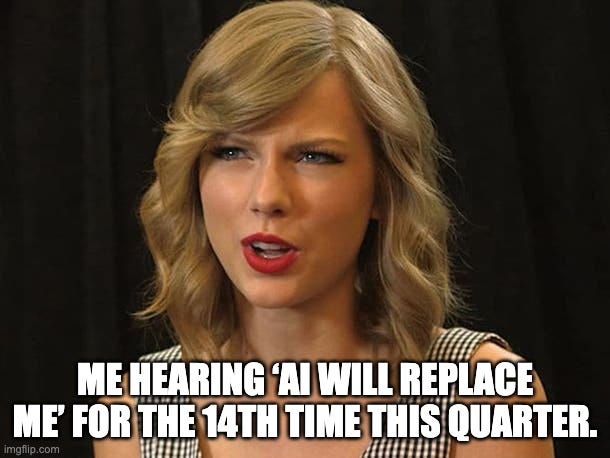The Autonomous SOC (Taylor’s Version)
Opening Act: Welcome to the SOC Show
Oh hi! If you’re in the cybersecurity space, autonomous SOC is probably a square on your keynote bingo card at this point. The term isn’t new, but the hype’s louder than ever. And honestly? It should be.
A few years ago, using automation or AI for investigation, triage, threat hunting, and incident response sounded like a fever dream told by someone who’d never worked a SOC queue. But now? The tech’s real, the models are better, and for once, “AI for cyber defense” doesn’t just mean another dashboard.
That said, before we hand the keys to the machines, core SOC foundations matter more than ever. Without clean data and aligned workflows, automation just multiplies the noise. If you don’t have a strong baseline, solid runbooks, and a team that actually communicates with each other, autonomy can quickly scale to chaos.
So let’s break it down. Era by era. SOC by SOC. Welcome to the show.
Era I: Manual to Automated - The Opening Act
Back in 2013, someone in the SOC told us one day everything would be automated and we wouldn’t need analysts. We didn’t buy it then, and we still don’t. This might be an unpopular opinion, but we don’t think the whole point of the autonomous SOC is to get rid of us. It’s to keep up. The challenges facing SOC teams are simply too fast, complex, and sophisticated for human capacity alone.
It all starts with a customer’s goals and maturity; what should we automate no,w and what can we automate “out of the way” so we can focus on higher value work? Maybe someday AI will handle it all, but right now it’s more nuanced than flipping “on” an AI switch.
Ideally, the autonomous SOC uses automation (including AI) to take over repetitive manual work so that analysts can focus on higher-level priorities like threat hunting or reverse-engineering malware. Humans and technology together make operations more efficient and more secure.
Era II: Back to Basics - The Rehearsal Room
Sorry to say it, but none of this fancy automation or AI matters if the basics are broken. That old saying, “garbage in, garbage out,” remains the first rule of an automated SOC. If you’re feeding the system sparse logs, incomplete data, weirdly formatted data, or pure noise, your shiny new tools (AI included) will only automate the wrong responses faster. You still need rock-solid processes. We’re talking updated runbooks and playbooks plus thorough documentation (don’t come for me).
Automation is the scale, but the foundational discipline is the weight you put on it. If the weight is garbage, the scale is pointless.
Era III: Why Now - The AI Remix
Why now? Because the perfect storm hit.
Attackers are using AI for offense, launching polymorphic threats at a speed no human analyst can match. The attack window, or the time between a breach and significant damage, has shrunk dramatically. To fight machine speed, we need machine speed.
Meanwhile, SOCs are drowning: talent shortages, burnout, and alert fatigue make human-only operations impossible to scale. Organizations can’t hire their way out.
And finally, defensive AI has matured. It’s evolved beyond basic rule-based automation to systems that can actually reason, enrich alerts, intelligently coordinate actions across different tools, and even recommend next steps. We’re at the point where the technology is genuinely capable of handling 80-90% of the Tier 1 and Tier 2 ticket load. This shifts the focus from “automation is nice to have” to “automation is survival.”
Era IV: The Road to Autonomy - Maturity by Milestone
As mentioned before, the road to the autonomous SOC isn’t a switch; it’s about measured steps.
Here’s what that looks like in practice:
Level 1: Automating phishing triage and ticket closure via SOAR.
Level 2: Using AI-assisted detection tuning or natural language-driven hunting.
Level 3: Predictive generation of new detection rules as AI recognizes emerging attack chains.
Level 4: Autonomous orchestration where AI executions respond without waiting for human verification.
These milestones help SOCs benchmark where they are and what’s next.
As SentinelOne’s maturity model notes, autonomy isn’t a single leap but a series of deliberate, tested steps.
True autonomy begins when AI systems can predict patterns, act safely, and give humans room to supervise instead of scrambling. Beyond that is Level 4, where AI takes on virtually all tasks, requiring minimal human intervention and allowing security experts to focus entirely on guiding the system and maintaining strategic resilience.
Era V: The Critics’ Corner - Bias, Trust, and the Drama of AI
Back when we were starting as analysts in 200-something (it doesn’t really matter), my shift lead told me, “always try to prove yourself wrong,” and that advice still holds true today.
One of the biggest hang-ups with an Autonomous SOC is the very human issue of trust and bias. We risk over-reliance or “automation bias.” It’s tempting to think, “AI said it was fine, so it must be fine,” but that leads analysts to skip the critical step of seeking confirmatory or contradictory evidence.
We are amplifying our security but we are also amplifying our mistakes. We have to maintain the “human-in-the-loop” because AI lacks intuition, ethical judgment, and business context. It can’t understand the intent or the politics of isolating a CEO’s laptop.
Bias in, bias out. AI is only as good as its training data. If historical bias labels activity from one region as risky, the system will automate that bias endlessly.
Then there’s the “black box” issue: deep learning models are so complex that the AI itself can’t tell you why it made a decision. It just says, “based on the input data, I am 98% certain this is bad,” without providing a clear, auditable trail of evidence. We need transparency or we can’t truly govern the system.
Era VI: The Midnight SOC - Where We’re Headed
It’s exciting to think about where this all leads. The future state of the SOC, what many are calling the Cognitive SOC, will redefine security roles entirely.
Tier 1 triage? Gone, handled by AI that processes 95% of alerts in seconds. What this really means is that the human analyst’s role is elevated entirely. They stop being reactive responders and become security architects, engineers, and strategic advisors.
The analyst as a coder/trainer: Analysts spend their time building, refining, and validating AI systems themselves. They write and optimize detection rules not for a SIEM but for the AI Agent, essentially teaching the machine how to think and decide within the guardrails of the business.
Proactive security as the default: Teams shift to proactive work such as threat hunting, red teaming, and AI-driven detection or AI engineering.
The business translator: Security becomes less about malware and more about business risk. Analysts will explain AI-generated insights in terms of financial impact: financial, regulatory, and reputational.
Ultimately, the SOC won’t just keep the lights on; they’ll be driving business resilience.
Autonomy doesn’t replace us; it remasters us.
So, are you ready for it?
References:
https://www.sentinelone.com/blog/introducing-the-autonomous-soc-maturity-model/
https://www.helpnetsecurity.com/2025/09/25/ai-powered-threats-protection/
https://www.techradar.com/pro/cybersecurity-executives-love-ai-cybersecurity-analysts-distrust-it
https://www.computer.org/csdl/journal/oj/2025/01/10858372/23VPu8d631m







my heart <3 this has reached its peak audience